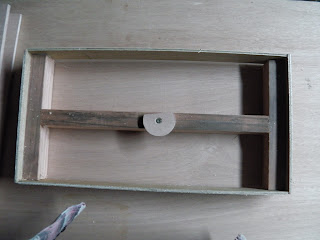In between spars I have been testing out a couple of ideas for parts of the boat. One of these is a latch for the cockpit floor panels. I intend to have a floor at both ends of the cockpit rather than standing on the hull planks. This will provide a flat surface to stand on and a small amount of storage under the floor. The floors will each consist of two plywood panels either side of the centreline supported all round by rails on the bulkheads and seat fronts and another support running along the centre of the keel. Most of the time gravity will keep these panels in place but, if the boat ever capsized, some sort of latches would be a good idea.
While thinking about this I saw the perfect solution on another boat and so decided to test it out and also work out how to make it. Here are a few photos of the test setup.
Two panels with finger holes so they can be lifted. The button in the centre is about 50 mm in diameter and it can rotate freely around the screw in the centre. In this position it is holding the panels down and they can't be lifted. The button is flush with the floor panels so there is nothing sticking up to trip on or hurt bare feet.
This exposes half the rail that supports the panels along the centreline.
Turning the button 180 degrees allows the other panel to be removed
This last photo shows the underside of the panel and the other part of the latch mechanism.
Making this little test setup took about 30 minutes. The parts are held together with hot melt glue, the button and hole in the panels were cut in one operation with a hole saw in the drill press. This exercise proved that the latch will work and helped me work out the proportions of the button and how to make it.





No comments:
Post a Comment